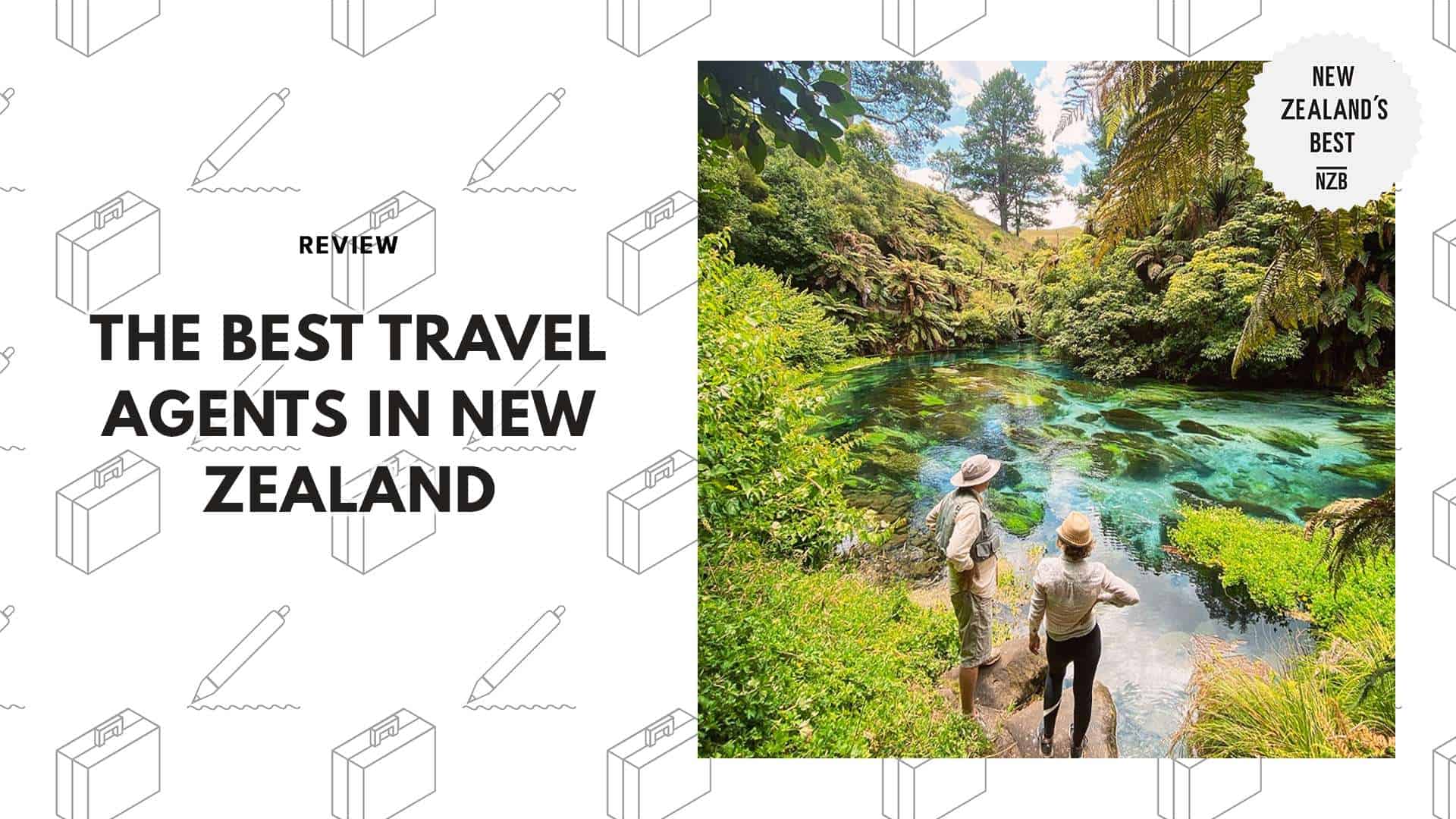The 12 Best Travel Agents In New Zealand
- Sweet As Travel
- Highlights
- Customer Reviews
- Acrossnz
- Highlights
- Customer Reviews
- Pacific Horizon
- Highlights
- Customer Reviews
- Guest New Zealand
- Highlights
- Customer Reviews
- New Caledonia Voyages
- Highlights
- Customer Reviews
- Nzega Education and Travel
- Highlights
- Customer Reviews
- New Zealand Guided Tours
- Highlights
- Customer Reviews
- First Light Travel
- Highlights
- Customer Reviews
- Rotorua Rafting
- Highlights
- Customer Reviews
- New Zealand Travel Organizer
- Highlights
- Customer Reviews
- Fine Tours New Zealand
- Highlights
- Customer Reviews
- Kia Ora Tour
When you travel without a plan, there’s always a chance that you’ll miss the most important places. That’s why you have the best travel agents in New Zealand — to ensure that doesn’t happen.
New Zealand is full of beautiful mountains, breathtaking oceans, wonderful rainforests, and amiable people. There’s also the rich culture, cuisine, and traditional products.
Your best chance of truly appreciating these is by going with the best travel agents on the island. These agents have the experience, the resources, and the logistical skill necessary to ensure amazing tours.
Today, we’ll help you out with that by presenting the best travel agents in New Zealand at the moment. These agents will take care of you and fulfill all your travel expectations!
1. Sweet As Travel

| Address: | Auckland, New Zealand |
| Contact: | +64 (0) 3 399 5259 |
| Age Range: | 18-35 |
| Tours for: | Groups |
| Social media | https://www.facebook.com/sweetastravel/ https://www.instagram.com/sweetastravel |
| Activities | Mostly outdoor activities like hiking, swimming, exploring, and surfing |
| Areas covered | North Island |
Price: NZD 349-1899 per person
Based in the city of Auckland, Sweet As Travel not only offers light prices but does everything possible to help you experience the country at its best.
They’re an especially good choice for North Island tours, as they do a lot of these. You’ll have these outdoor activities like hiking, swimming, and kayaking.
Their tour locations are well-thought out to balance adventure and rest for tourists. Plus, you won’t need to spend a dime on breakfast, lunch, and dinner, because they’re included.
Highlights
- Adventurous itinerary
- Chance to know more about the place with the crew!
- Tours filled with fun outdoor activities or leisure
- Free breakfast, lunch, and dinner
Customer Reviews
All travelers reviewing this agency gave it the highest score of excellent without any negative comments on TripAdvisor. Reviewer maxmaxmax3 says:
“I came with a group of about 25 people for a study abroad trip. Rich, the proprietor of Sweet As, was our guide for our North Island tour. Rich and his assistant Diane were the friendliest people I met in my entire stay, and even more knowledgeable about NZ lore. We checked every amazing location on the North Island off the list, and got to walk in the Redwoods, Duneboard, and even explore multiple hot springs. My only complaint about this trip is that it wasn’t longer! 10/10 would recommend!”
2. Acrossnz

| Address: | 12 Princess Street P.O. Box 567, Christchurch, New Zealand |
| Contact: | +64 (3) 420 4000 |
| Tours for: | Coach, Package, Self Drive tours, Honeymoon |
| Activities | Hiking, sightseeing, swimming, dining, etc |
| Areas Covered | New Zealand-wide |
Price: NZD 530-20,000 per person
Another of the best travel agents in New Zealand is Acrossnz. They offer a variety of tours catering to different budgets and interests.
You can even arrange a cruise tour with them. This is your chance to increase your understanding of local culture, appreciate the splendour of New Zealand’s cities, and meet enthusiastic travelers like you.
You can also enjoy the breathtaking scenery of both the North and South Island with this travel agency. They offer visits to Hobbiton, glacier tours, and tours to geysers and hot springs.
Highlights
- Self-drive and rental campervan packages
- Perfect for couples or a group of friends
Customer Reviews
People have left nice reviews for this agency. They praise the agency’s staff, in particular, for setting up their itinerary for them, the place to stay, and fun activities.
The catch (particularly if you choose their self-drive tours) is that you have to do some of the work of travelling by yourself (like driving!). However, customers say the rewards are more than worth it.
Let’s see this review from Nori:
“We arrived home safely last night. Thank you for arranging everything for us. We were indeed mesmerized with what New Zealand has to offer. Fantastic accommodation especially the Hilton in Queenstown and Mt Cook – we should have two nites there instead next time cos we arrived very late like 10pm. We truly enjoyed the gracefulness and hospitality of Ann and husband Brian at the Nokomai farm even tough were lost in getting it there – not much of a signage. …Thanks and will recommend your services to any of my friends or relatives who are planning to visit New Zealand.”
3. Pacific Horizon

| Address: | Motorhome pick-up and drop-off depots located in Auckland, Wellington & Christchurch |
| Contact: | +64 4 233 8881 0800 808 882 (Freephone within New Zealand) 1800 284 315 (Freephone from Australia) [email protected] [email protected]. |
| Tours for: | Self-tour with travel tips from Pacific Horizon personnel |
| Activities | Motorhome and campervan rental | https://pacifichorizon.co.nz/ |
| Areas Covered | New Zealand wide |
Price: Contact for more information
Book today with Pacific Horizon here
Pacific Horizon Motorhomes is a privately owned and operated New Zealand business that offers rental for a range of motorhomes for travellers to hire and enjoy all the scenic beauty that can only be found in New Zealand.
When you book a Pacific Horizon motorhome not only will you get a top quality vehicle of no more than four years of age in excellent condition, but you’ll also get a friendly & helpful greeting to begin your New Zealand holiday.
Highlights
- All of Pacific Horizon motorhomes are designed and built in New Zealand, specifically for New Zealand conditions and safety requirements
- All are automatic transmission for easy driving, and feature forward-facing rear passenger seats in all models – mostly with full lap and diagonal seat belts and multiple child car seat tether points for extra safety
- Every motorhome and campervan in our fleet has an onboard toilet & shower, and is fully self-contained and certified for freedom camping in designated areas.
- All motorhomes also come with insulated walls and floor, double glazed windows, and roof-mounted solar panels, along with diesel or gas heating/cooling for the changing climates of New Zealand.
- All mid-sized and larger motorhomes (ie GEM, 4-berth, and SAM) also feature dual rear wheels and rear wheel drive for extra safety, stability and traction.
Customer Reviews
Here’s a review by Shane Howe from the website:
“It’s true ‘you get what you pay for’. Pacific Horizon may not have been the cheapest but I am very satisfied with the quality of our hire motorhome and the level of service we received. They were very helpful during the booking stage, and promptly picked us up and dropped us back to our Motel. It truly made it a great holiday, and I would have no problem in recommending them. We will certainly use their services again.”
4. Guest New Zealand

| Address: | Galeo Estate, Redwood Valley 7081, New Zealand |
| Contact: | +64 21 629 498 | [email protected] |
| Age Range: | All Ages |
| Tours for: | Honeymoon, Family Holiday, Nature Vacation |
| Social media | Youtube: https://www.youtube.com/channel/UCs48O1QK5lf7P6Hyv5gVR8A Twitter: https://twitter.com/guestnz Facebook: https://www.facebook.com/GuestNZ Instagram: https://www.instagram.com/guestnz/ LinkenIn: https://www.linkedin.com/company/guest-new-zealand/ Skype: skype:michaelnees?add |
| Activities | Cruise, Rafting, Thermal Spring, Sightseeing, Hiking |
| Areas covered | New Zealand wide |
Price: Contact company for precise quotations
Website: https://guestnewzealand.com/
If you ever plan on visiting the beautiful country of New Zealand, it is important to get the best travel agency that will guide you all throughout your trip in the country. Being spontaneous is good, but having plans are much better, so that you can have the best New Zealand experience.
Acquiring Guest New Zealand’s services will be the best choice for you if ever you’re visiting New Zealand. Specialising in Boutique Travel, they have designed the most exciting and memorable itineraries for you.
Save yourself the trouble of planning your trip and let Guest New Zealand pamper you with their prepared services. Treat yourself with a hassle-free and one of a kind experience in New Zealand!
Highlights
- Authentic Travel
- Hand-picked Local Accommodation and Small Tour Activities
- Smart Technologies
Customer Reviews
Here is a review left by a very satisfied client:
“We spent 30 days on the South Island. Michael organized a diverse trip consisting of hiking, wineries, sheep ranches and the most gorgeous places to stay. Michael’s service level was over the top! We were in constant touch with him especially toward the end when we needed his guidance regarding leaving due to the Corona virus. If you plan to go to New Zealand I highly recommend Michael. He will guide you to the most beautiful places and you will stay in small intimate and very special boutique inns with the most personable and knowledgeable hosts. Michael knows all the special nooks and crannies of New Zealand. Our trip was beyond fabulous!” – Annemarie Gilly
5. New Caledonia Voyages

| Address: | Level 26, PwC Tower, 188 Quay Street, Auckland, New Zealand |
| Contact: | Phone: 0800 890 118| +64 9 889 3618 Email: [email protected] |
| Tours for: | Noumea Holiday Packages Self Drive Holidays Isle of Pines Holiday Packages Loyalty Islands Holiday Packages Family Holidays Golf Holidays French Language Holidays Special Offers New Caledonia Honeymoon Packages |
| Activities | https://www.newcaledoniavoyages.co.nz/activities |
| Areas Covered | New Zealand wide |
Price: Starting at $1090 per person
Book Today On New Caledonia Voyages Here
If you’re a lover of all things French seeking an island getaway, look no further than New Caledonia Voyages’ holiday packages – an idyllic French collective of islands in the South Pacific, only a three-hour direct flight from Auckland.
Their packages include flights, transfers, breakfast and much more, and they’ve found the best deals to experience the culinary delights of the cosmopolitan capital Nouméa and the archipelago’s secluded white beaches and pristine ocean.
Highlights
- New Caledonia Holiday Packages from New Zealand
- New Caledonia Honeymoons
- New Caledonia Tailor made holidays
- Group Travel to New Caledonia
Customer Reviews
5-star Facebook review from Sep Ashkani:
“I Highly recommend New Caledonia Voyages to anyone who’s thinking about booking their next travels through them. I was dealing with amazing Julie, she gave me some great travel tips, places to visit and she was super helpful! I was extremely happy with the itinerary she had planned for me!! Thank you ??”
6. Nzega Education and Travel

| Address: | PO BOX 27109, Christchurch |
| Contact: | F: +64 3 934 7104 [email protected] |
| Tours for: | https://nzega.com/roteiros-nz/ |
| Activities | https://nzega.com/roteiros-nz/ |
| Areas Covered | New Zealand wide |
Price: Contact for more information
NZEGA tailors to travelers for all types – whether you are traveling alone, with family, in a group, backpacking or on technical and corporate tours, taking into account your profile and pocket. Because they are located in the country, they know the best options to travel in New Zealand, travel in Australia and travel in the Fiji Islands.
NZEGA is also a member of the Tourism Industry and has a contract with all extreme sports, winter sports, transportation, activities and accommodation companies.
Highlights
- Customisable trips
- Trips for South Island and North Island in New Zealand
Customer Reviews
5-star Facebook review from Livia Tavares Souto:
“Best travel and education agency if you are thinking about coming to travel or study in NZ ou Australia! Highly recommended!”
7. New Zealand Guided Tours

| Address: | 37 Reece Crescent, Wanaka 9305, New Zealand |
| Contact: | +64 3 443 2111 | [email protected] |
| Age Range: | All Ages |
| Tours for: | Most Popular Family Tours Lord of the Rings Luxury Tours Small Group Tours Private Tours Tours from USA |
| Social media | https://www.facebook.com/newzealandtravelorganiser/ |
| Activities | Hiking, Cruise, Dinner, Spa, Scenic Flights, Workshops |
| Areas covered | North Island South Island New Zealand |
Price: Contact company for precise quotations
Website: https://www.newzealandguidedtours.com/
A guided tour would be the best option for you if you’re going to a new country. Luckily, New Zealand Guided Tours is there to help you find the best packages that will let you see the beauty of New Zealand.
What’s great about them is that you may choose from over thirty tours, each that are excellent by their own merit. They also make sure to include the top destinations for both the North and South Islands of New Zealand.
With New Zealand Guided Tours, you can see beautiful spots like Milford Sound, Lake Tekapo, Mount Cook, Franz Josef Glacier, Bay of Islands, Coromandel Peninsula, and many more places, all at a reasonable price!
Highlights
- Superb tour guides
- Fully customised, one-of-a-kind itineraries
- Excellent accommodation
Customer Reviews
You can bet that New Zealand Guided Tours has received nothing but good praises from travelers from all over the world. They’re truly one of the best in the field, making sure that each and every client will leave New Zealand happy and wanting to go back as soon as possible. Here’s one of the feedbacks left by one of their satisfied customers:
“Thank you for the excellent arrangements. We all had a fantastic time. My group members thoroughly enjoyed their NZ holidays. Every one praised the excellent tour program. They thoroughly enjoyed the good, varied food & the spectacular scenery. The driver, Richard, was very knowledgeable & a skilful driver. Patrick, the tour guide, is very helpful and caring. We really had a wonderful time in NZ. Thank you, Rebecca, for the excellent NZ holidays!!” – Dr. Luan
8. First Light Travel

| Address: | Level 2, 69-71 Beach Road Auckland, Aotearoa New Zealand |
| Contact: | 09 281-4481 |
| Tours for: | Self-drive tours, group tours |
| Facebook page: | https://www.facebook.com/firstlighttravel |
| Activities | Mountain biking/cycling, hiking, walking, food & wine, surfing, sailing, kayaking/rafting, birding, fly fishing |
| Areas Covered: | New Zealand-wide |
Price: NZD 175-7275 per person
There are a wide range of choices to travel to in the Kiwi islands. If you’re at a loss on where to begin, you can let First Light Travel devise the perfect itinerary for you based on what you like and enjoy the most.
Upon visiting their webpage, the first step is to enquire so they’ll know you better and tailor-make your itinerary.
There are a ton of activities you can indulge in with First Light, such as hiking, biking, fishing, surfing, and many more.
First Light Travel is also a certified Qualmark Gold travel company. This means they give customers the best travel arrangements and of course, provide safety for all.
Highlights
- Trips will be inviting, safe, and eco-friendly (Qualmark Gold)
- Let them assist you to set your travels for you
- LOTR tours, self-drive, coach, luxury or romantic/honeymoon tours
Customer Reviews
Customers appreciated the agency’s staff being helpful and informative. For instance, this review is written by rellast1, giving them a 5-star rating on Trip Advisor:
“Shelley at First Light Travel was awesome in putting together our South Island NZ itinerary. We are a family of four, with two teenage boys, aged 13 and 17, so wanted some adventure, whilst fitting in some relaxation and beautiful scenery. We already had an idea of what where we wanted to visit and some activities and Shelley was able to fine-tune out ideas for the better and made it an easy and seamless holiday. From the perfect accommodation for our family’s needs (including kitchenettes in all motel rooms) to the hire car and pre-booked activities like rock climbing, cruises, gondola rides and zip lining. The choices are endless. The scenery is spectacular. I highly recommend Shelley and the team at First Light Travel, after a friend used them and recommended to me. It saved us a lot of time and stress.”
9. Rotorua Rafting

| Address: | 103 Okere Rd – 3074, Okere Falls, New Zealand |
| Contact: | 0800 772 384 |
| Tours for: | Private Tours |
| Activities | White water rafting/kayaking |
| Areas covered | Rotorua |
Price: NZD 85-95 per person
Check Out Rotorua Rafting Here
Looking forward to a tour that will have you rafting or kayaking on a roaring river? With Rotorua Rafting, you’ll enjoy splashdowns in a number of exciting tour choices!
You can take on the fast currents of Kaituna river rapids before plunging down the 7-metre high Tutea falls, for instance. This is the best one to choose if you don’t mind getting wet.
Or for a mid-paced culture-focused tour, you should pick the Okere Awa. Here you’ll learn about the Maori and New Zealand as a whole.
This agency also offers paddleboarding tours on New Zealand’s lakes for a more laid-back but still-active experience. As with all of their other tours, expert staff will look after you during the tour.
Highlights
- Experience the thrilling whitewater rafting in Rotorua!
- Get to know more about Maori history and culture
- Kayak with your friends along the wild Kaituna River, Okere Awa, and Rangitaiki River
- Many options for those who prefer exciting or “active” tours
Customer Reviews
There’s no doubt that Rotorua Rafting has some of the best travel agents in New Zealand. A lot of their clients say that the agency’s people are very informative and kept them safe and well all throughout their tours:
“It was a wonderful experience. There was lots of apprehension before the ride n the guide COBA was so cool n calm that he literally relaxed us n made the ride so exciting that we wanted to do it again. Loved it. Worth experiencing.” (River rafting at Kaituna rotorua)
And elisarachelrose wrote:
“Definitely don’t miss this if you’re in NZ. Great team – they take good care of you, and it’s so much fun!”
10. New Zealand Travel Organizer

| Address: | 37 Reece Crescent, Wanaka 9305, New Zealand |
| Contact: | +64 3 443 2111 | [email protected] |
| Age Range: | All ages |
| Tours for: | Family, Couples, Group |
| Social media | https://www.facebook.com/newzealandtravelorganiser/ |
| Activities | Family Packages NZ Self Drive Coach Tours Luxury Packages South Island North Island Guided Tours Ski Packages |
| Areas covered | North Island |
Price: Contact company for precise quotations
Website: https://www.nztravelorganiser.com/
If you’re looking for a company that creates spectacular, affordable, and memorable tour agendas in New Zealand, then this is the one for you. New Zealand Travel Organizer offers tour packages for places all over the country, each personally curated based on their group’s experience.
You may choose among a variety of package options, such as self drive tour, private tour, family, and even a luxury tour. You can opt to stay on one side of the country or explore its beauty entirely. Whatever you decide to do, New Zealand Travel Organizer is sure to make your stay the best.
Highlights
- Premium Vehicle & Full Insurance
- 4 Star Accommodations
- Top Rated Activities
- Personal Tour Planning
Customer Reviews
Travelers have applauded New Zealand Travel Organizer for their wonderful packages, all at a reasonable price. Each destination was nothing short of amazing, and truly shows how beautiful the country is. Take a look at what one client had to say about their services:
“Thanks to our New Zealand travel Organiser, Kelly, we had an amazing time in NZ. The planning and booking process was easy, effortless and painless. We received all the information for the different activities and itinerary for the different places we visited. Kelly thought of everything, weather for the time we were there, currency exchange, recommendations for places to go, etc. We definitely recommend New Zealand Travel Organiser, to our friends and family and we will come back!”
11. Fine Tours New Zealand

| Address: | Level 1, 93 Ardmore Street, Wanaka New Zealand |
| Contact: | 64-3-443-0812 |
| Tours for: | North and South tours, LOTR tour, self-drive, and luxury and vacation tours |
| Activities | Train rides, hiking, driving, sightseeing, dining and accommodations |
| Areas Covered | New Zealand wide |
Price: NZD 2,597-33,431 per person
Book Today On Fine Tours NZ Here
When vacationing, time is very important as there is never enough time to roam and see everything in the place you’re visiting. That’s where Fine Tours NZ can help, as they try to arrange tours so that you can see everything that interests you.
This agency provides a lot of tours and you don’t have to be concerned about a single thing during them. The agency’s staff will handle everything from your schedule to accommodations, cancellations, and others.
Highlights
- Arrangement for a spectacular NZ excursion
- Unforgettable trips that still fit your budget
- Choose from hundreds of tours available
Customer Reviews
Vacationers and honeymooners alike were impressed by Fine Tour’s well-planned itineraries as well as the agency’s ability to consider their budget. They say that with the agency, they had a pleasant time visiting New Zealand.
This is why Fine Tours NZ is included in our list for the best travel agents in New Zealand. Here’s a review by Carolyn Kiel and Theresa Rodrigues from the website:
“Absolutely wonderful itinerary and tour!! Everything was planned and communicated extremely well by Shelley and all worked like clockwork!! Wonderful trip with many very special memories: People, scenery, LotR movie sites, tour guides, interisland ferry, accommodations, car rental, etc were all excellent and as described! No hidden costs! The documents provided were exceptionally clear and presented great detail to ensure we had the right expectations, and everything surpassed them! Really very organized and an outstanding tour! Thank you for all of your expertise and planning on our behalf, Shelley! A wonderful trip through New Zealand and once-in-lifetime trip to Middle Earth! THANK YOU!”
12. Kia Ora Tour

| Address: | Auckland, New Zealand 0620 |
| Contact: | [email protected] Linda: +64 21 081 93122 Syarief: +64 21 2842542 |
| Tours For: | Private Tours, Self Drive Tours, Group Tours, Speciality Tours |
| Activities: | Golf Tours, Farm Tours, Cycling Tours, Bike Tours, Adventure Tours |
| Area Covered: | Spans the entire country from North to South North Island includes Auckland Rotorua Hobbiton Waitomo Wellington South Island Queenstown Milford Sound Christchurch Dunedin |
Kia Ora Tour provides one-of-a-kind experiences to help you make the most of your time in New Zealand and Indonesia.
Take a once-in-a-lifetime trip with your own vehicle and local guide/driver. Just sit back, relax, and enjoy your trip; they’ll take care of the rest. They will make certain that you experience the best that New Zealand has to offer.
They will provide you with all of the information you need, such as where to go and what to do, but this is your trip, so you must decide what is best for you. They provide a wide range of accommodations, restaurants, and activities, as well as the best places to stop and take photos for a permanent record of your road trip. They’ll be on the phone if you need us at any point during your trip, ready to help or answer any questions you may have.
Discover New Zealand with their exciting range of hassle-free, all-inclusive Group Tours that span the entire country from north to south. Their luxury coaches, experienced drivers, and a careful balance of sightseeing, activities, and free time ensure that all you have to do is sit back, relax, and enjoy the ride. You can either form your own group or join one that already exists.
They understand that their clients have a wide range of interests, and they can accommodate most special requests. They can arrange Golf Tours, Farm Tours, Cycling Tours, Bike Tours, Adventure Tours, and many other activities. So get in touch with them and tell them what you’re interested in, and they’ll put together a customized itinerary to ensure you see the best of New Zealand.
Highlights
- Custom tours
- Offers long and short tour durations
- Ideal for family or group tours
- Good organization
- Transfers are available
Customer Reviews
“Very pleasant experience… well organized tour and very helpful in every single thing we need. Everything was handled with a smile… highly recommended, be it for private tour for small or big family or group tour… thanks Kia Ora Tour 😍” – Soraya Ambadar
“Very well organized tour and very helpful in every even we did in our trip…also very good for private tour for small and big family..hope they can help you in the future!” – Nico Antonio Santoso
This list of the best travel agents in New Zealand should help you book your travels easily and effortlessly. If you have any comments or suggestions, don’t hesitate to write them below.
And don’t forget to tell your travel agent if you need to drop by someone you know on the island! They can usually arrange that easily enough, particularly for custom tours.
If it can’t be managed, though, you can always just send them a present to say hello. For example, why not check out the best flower deliveries in Auckland if you have friends you want to surprise in the area.



